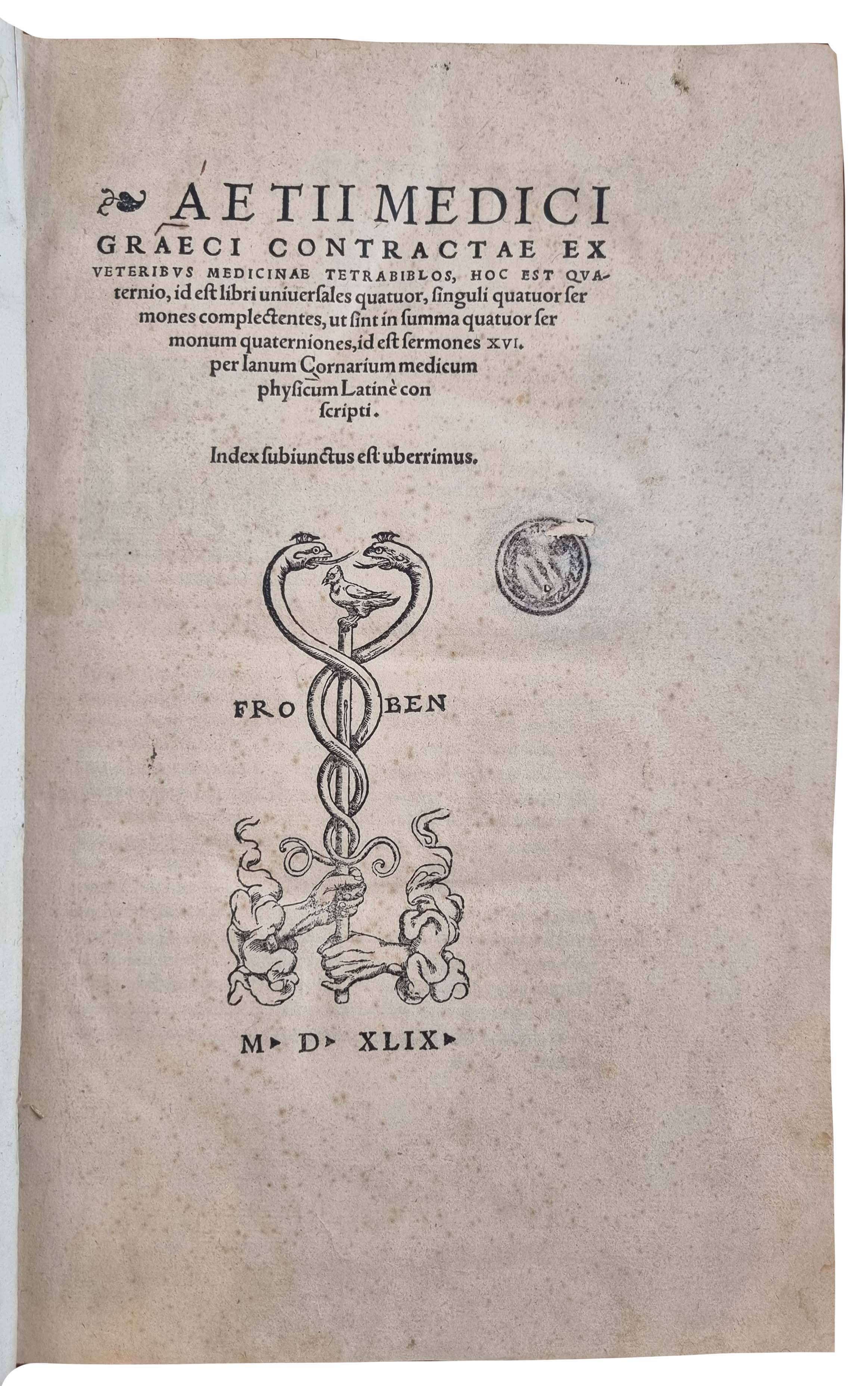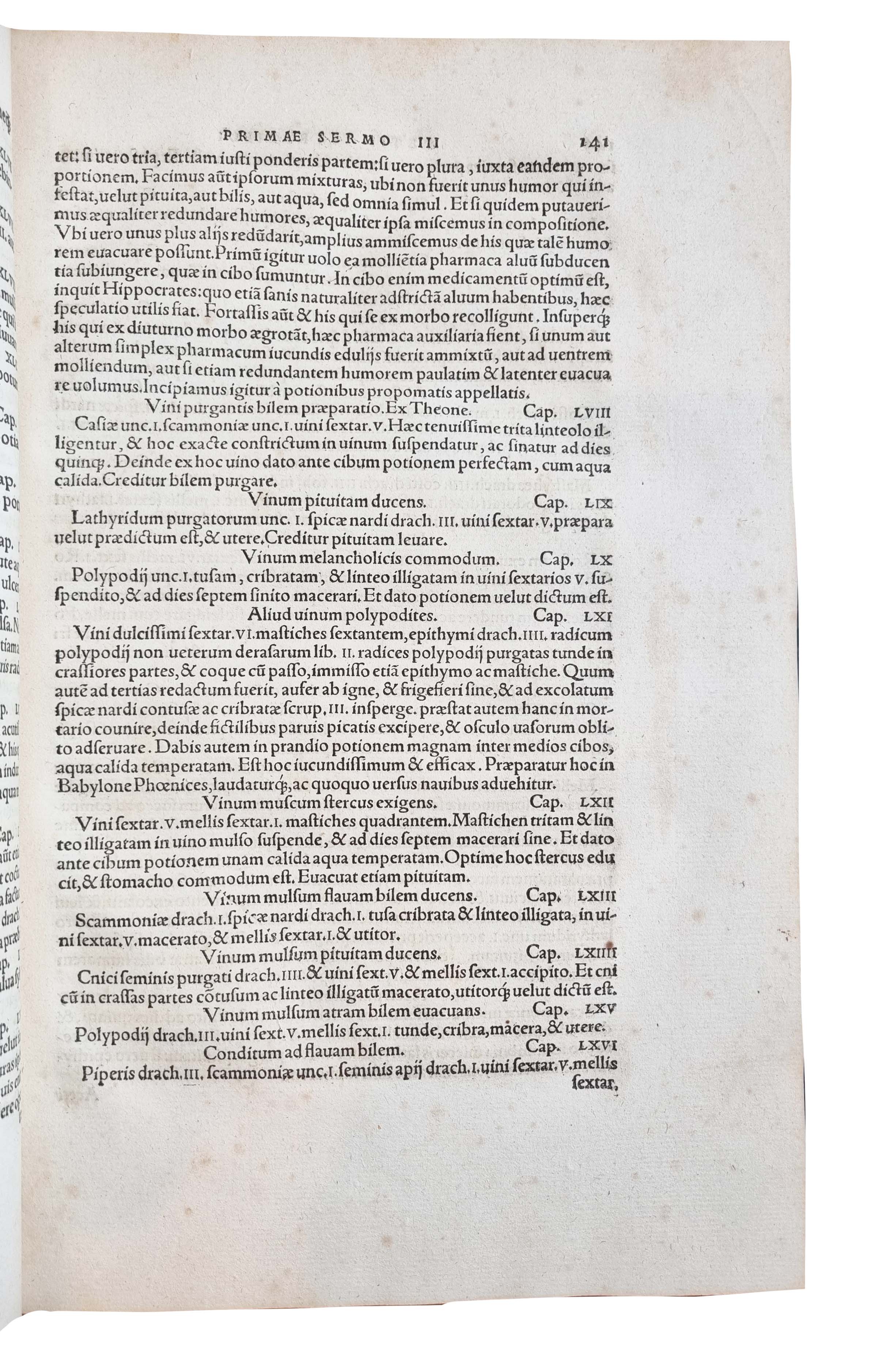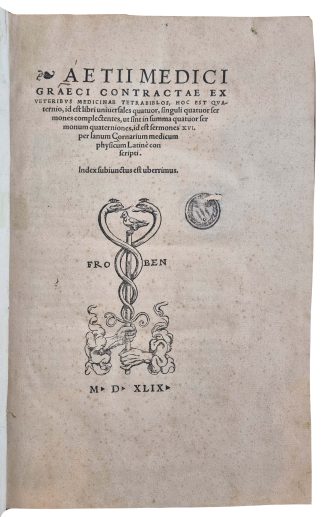AETIUS, Amidenus.
Contractae ex veteribus medicinae tetrabiblos
Basel, Froben, 1549£1,750.00
Folio, pp. (xii) 916 (lvi). Roman letter, attractive woodcut historiated and floriated initials, typographical ornaments, printer’s device on t-p and verso of last. T-p a bit dusty, lightly spotted, age yellowing, browning to a few ll., minor mainly marginal foxing. A good, wide margined copy in C17 quarter calf with probably 18C blue patterned boards, edges worn, spine with raised bands a bit worn at extremities but firm, all edges sprinkled red. Unidentified early black circular stamp with small hole to t-p, autograph of Alessandro Volpi (1844-1857) to verso.
A good copy of this medical encyclopaedia by the Greek Aetius. This is the second edition (first 1542) of the Latin translation by Janus Cornarius (c. 1500-1558), Saxon humanist, philologist and friend of Erasmus.
A native of Amida in Mesopotamia (modern Diyarbakır, Turkey), Aetius was a Greek medical writer who lived about the end of the fifth and beginning of the sixth century. Very little is known of his life: he studied at Alexandria – at the most famous medical school of the time – and lived in Byzantium, where he became court physician to the Emperor Justinian I. Highly regarded by Renaissance physicians, he is defined here by Cornarius as the greatest of medical writers. Aetius’ ‘Tetrabiblos’ – so called because it comprises four books, each divided into four parts – is an extremely valuable and important medical treatise. In fact, it is a compilation from the writings of several authors, many from the great library at Alexandria, otherwise lost. In particular, we find the works of Ruphus of Ephesus and Leonides in surgery, Soranus and Philumenus in gynecology and obstetrics, but also Aetius’ own observations on diseases and treatments.
An interesting feature of Aetius’ work is that of providing recipes for creating complex medical compounds composed of many ingredients, typical of the time. Among the most complicated concoctions, we find a plaster recommended for tumors, hard lumps and gout; among the most curious, there is one for contraception consisting of aloe, wallflower seed, pepper, and saffron. Interestingly, “Aetius […] introduced much of Egyptian pharmacy, and was particularly fond of external applications, as well as of charms and amulets so common in the same country. In composing a certain ointment he required that there should be repeated in a loud voice, “May the God of Abraham, the God of Isaac, and the God of Jacob deign to accord virtues to this medicine” (Dunglison). However, “It was from Galen himself and not from the east that Aetius derived his most strikingly superstitious passages. […] for example, the use of an amulet of a Greek jasper suspended from the neck by a thread so as to touch the abdomen; the story of the reapers who found the dead viper in their wine and cured instead of killing the sufferer from elephantiasis to whom they gave the wine to drink” (Thorndike). Remarkably, appended at the end is also Coronarius’ translation of a short treatise on weights and measures by Paul of Egina.
This copy belonged to Alessandro Volpi (1844-1857), an Italian veterinary physician and grandson of Antonio Volpi, professor of law and rector of the University of Pavia. He is the author of numerous scientific publications on veterinary medicine and zoology, but also wrote on history and politics. Other volumes from his library, bearing the same characteristic signature, are held in the collections of the Biblioteca Marciana in Venice.
USTC 600293; Durling 48; Graesse I, p. 39. This ed not in Adams, BM STC Ger 16th century, Garrison-Morton, Welcome I, Heirs of Hippocrates. R. Dunglinson, History of Medicine from the Earliest Ages to the Commencement of the Nineteenth Century 916 (1872). L. Thorndike, A History of Magic and Experimental Science, Vol 1 (2003).In stock




